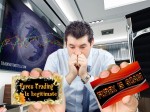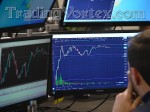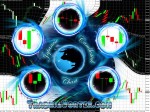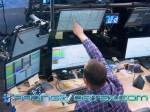Table Of Contents:
- Introduction to High-Frequency Trading:
- How High-Frequency Trading Works?
- Opportunities in High-Frequency Trading:
- Risks Associated with High-Frequency Trading:
- Regulatory Environment for High-Frequency Trading:
- Technology and Infrastructure Requirements:
- Ethical Considerations in High-Frequency Trading:
- Future of High-Frequency Trading:
- Wrapping Up – The Fast Lane of High-Frequency Trading:
Introduction to High-Frequency Trading:
What is High-Frequency Trading?
So, let's dive right into high-frequency trading, or HFT as we traders like to call it. If you've been around the trading block, you know that HFT is essentially the racecar of the financial markets. We're talking about trading that happens at lightning speed – trades executed in microseconds. Imagine a supercharged Ferrari darting through market data, grabbing opportunities faster than you can blink. HFT uses complex algorithms and supercomputers to buy and sell securities at speeds and frequencies that are humanly impossible to match.
But let's clear up a common misconception – HFT isn't about gambling. It's about leveraging advanced technology and strategies to exploit tiny price inefficiencies. These aren't your get-rich-quick schemes; they're highly sophisticated operations that require significant investment in technology, research, and expertise.
History and Evolution of High-Frequency Trading:
Now, how did we get here? The story of HFT is pretty fascinating, and it's a tale of technological evolution. Back in the day – think the 1990s – trading floors were bustling with brokers shouting orders. Fast forward to today, and it's all about silent, air-conditioned rooms filled with rows of servers humming away.
The seeds of HFT were planted with the advent of electronic trading in the late 20th century. When the NASDAQ introduced its electronic trading system in the 1980s, it set the stage for a revolution. By the 1990s, with the internet and computing power growing exponentially, early adopters of HFT started making waves.
Remember 2006? That's when the NYSE launched its hybrid market, blending traditional floor trading with electronic trading. This was a game-changer. Suddenly, the speed of execution became a crucial edge. By the late 2000s, HFT firms were dominating trading volumes, making up over half of all U.S. equity trades at their peak.
Key Characteristics of High-Frequency Trading:
So, what makes HFT tick? Let's break down some key characteristics:
- Speed: Speed is the name of the game in HFT. We're talking about trades happening in microseconds. To put that in perspective, that's a millionth of a second. Firms invest heavily in cutting-edge technology to shave off even nanoseconds from their execution times.
- Volume: HFT involves executing a large number of trades daily. These trades might be small individually, but they add up quickly. It’s like catching pennies falling from the sky – each one might be tiny, but gather enough and you’re rich.
- Algorithms: At the heart of HFT are complex algorithms designed to identify and capitalize on minute market inefficiencies. These algorithms are constantly being tweaked and optimized to stay ahead of the competition.
- Short Holding Periods: In HFT, positions are held for incredibly short durations – sometimes just milliseconds. The aim is to avoid market risk by not holding positions overnight.
- Market Making and Arbitrage: Many HFT strategies revolve around market making (providing liquidity by buying and selling continuously) and arbitrage (taking advantage of price differences across markets).
- Co-location: HFT firms often co-locate their servers as close as possible to the exchange's data centers to minimize latency. Think of it as setting up shop right next to the exchange to get your orders in a split-second faster than the guy down the street.
In my experience, navigating the world of HFT is like being in a high-stakes poker game where everyone has the best cards and knows how to play them. It’s thrilling, challenging, and requires a sharp mind and steady nerves.
Whether you're an experienced trader or a curious investor, understanding the ins and outs of HFT can give you a deeper appreciation of the intricate dance that makes the financial markets tick. So, buckle up, and let's continue exploring this fast-paced world where milliseconds mean millions and every tick of the clock can spell opportunity or risk.
How High-Frequency Trading Works?
Alright, let's roll up our sleeves and dig into the mechanics of high-frequency trading (HFT). It's like peeking under the hood of a Formula 1 car – complex, powerful, and fascinating. This section will demystify how HFT operates, from the cutting-edge technology driving it to the intricate strategies traders use to stay ahead of the pack.
The Technology Behind High-Frequency Trading:
First off, let’s talk tech. If HFT were a superhero, its superpower would be speed, and its secret weapon would be an array of advanced technologies. High-frequency traders rely on high-performance hardware and software to execute trades at breakneck speeds. Imagine a room full of servers, all working tirelessly to crunch numbers and execute trades faster than you can say "trade executed."
One key piece of tech is the algorithm – these are the brains behind the operation. These algorithms are like intricate recipes, carefully designed to identify and exploit tiny market inefficiencies. They analyze vast amounts of data in real time, making split-second decisions that would be impossible for a human to replicate.
Now, these algorithms need a robust infrastructure to function. This includes ultra-low latency networks, cutting-edge processors, and high-speed data feeds. Traders often go to great lengths to minimize latency – the delay between receiving market data and executing a trade. They achieve this by co-locating their servers physically close to exchange data centers, reducing the time it takes for data to travel.
Another critical element is the data itself. HFT firms consume massive amounts of data, including real-time market quotes, historical price data, and even news feeds. This data is the fuel that powers their algorithms, helping them make informed trading decisions in milliseconds.
Strategies Employed in High-Frequency Trading:
High-frequency trading isn’t a one-size-fits-all game. Traders employ a variety of strategies to make the most of their technological edge. Let’s dive into some of the most popular ones:
Market Making:
Market making is like being the guy at the party who’s always ready to buy or sell. HFT firms provide liquidity to the market by continuously placing buy and sell orders. The goal is to profit from the bid-ask spread – the difference between the buy (bid) price and the sell (ask) price. It’s a bit like being a merchant who buys goods at a lower price and sells them at a higher one, but at super speed.
As a market maker, you need to stay nimble, constantly adjusting your prices to reflect the latest market conditions. It’s a dance that requires precise timing and a keen understanding of market dynamics.
Arbitrage:
Arbitrage is all about taking advantage of price discrepancies between different markets or instruments. Imagine you’re at a farmers’ market and notice that apples are cheaper at one stall than another. You buy the cheaper apples and sell them at the higher price – that’s arbitrage in a nutshell.
In the HFT world, this might involve spotting a price difference for the same stock on different exchanges and exploiting it. These opportunities are often fleeting, lasting just milliseconds, which is why speed is crucial. The algorithms used for arbitrage need to be lightning-fast and incredibly precise.
Statistical Arbitrage:
Statistical arbitrage, or "stat arb" as we like to call it, is a bit more sophisticated. It involves using mathematical models to identify trading opportunities based on statistical relationships between different financial instruments. Think of it as finding patterns and correlations that aren’t immediately obvious.
For example, if two stocks usually move together but suddenly diverge, a stat arb strategy might involve betting that they will revert to their normal relationship. These strategies require deep knowledge of mathematics and statistics, as well as powerful computing resources to analyze the data.
Momentum Ignition:
Momentum ignition is a more controversial strategy. It involves initiating a series of trades to create a perception of market movement, thereby encouraging other traders to jump on the bandwagon. Once the momentum builds, the HFT firm can profit from the resulting price movement.
Think of it as starting a small snowball rolling down a hill and then profiting as it gathers size and speed. This strategy requires careful planning and precise execution to avoid detection and potential regulatory issues.
In my own trading journey, I’ve seen firsthand how these strategies play out. It’s like being part of a high-stakes chess game, where every move is calculated, and every millisecond counts. High-frequency trading can be incredibly rewarding, but it’s not for the faint of heart. It requires a deep understanding of both the markets and the technology that powers them.
So, if you’re thinking about diving into HFT, be prepared for a wild ride. It's a world where milliseconds mean millions, and success hinges on your ability to stay one step ahead of the competition.
Opportunities in High-Frequency Trading:
Alright, let’s switch gears and talk about the golden opportunities in high-frequency trading (HFT). This is where things get exciting. Whether you're a seasoned trader or an investor with a keen eye on the markets, understanding the potential that HFT holds can open up a world of possibilities. Let’s break it down and see how you can capitalize on these opportunities.
Profit Potential and Market Efficiency:
First up, the most obvious lure of HFT: profit potential. Imagine being able to exploit tiny price discrepancies thousands of times a day. Sounds like a dream, right? Well, for HFT firms, it's a reality. These firms thrive on minuscule margins but make up for it with high volume. The sheer speed and frequency of trades mean even small price movements can add up to significant profits.
But there’s more to it than just raking in the dough. HFT also plays a crucial role in enhancing market efficiency. By constantly scanning and responding to market conditions, HFT traders help ensure that prices reflect available information accurately and quickly. It’s like having a swarm of bees that pollinate the market, keeping everything buzzing smoothly and efficiently.
Liquidity Provision and Spread Reduction:
Now, let’s talk liquidity – the lifeblood of any market. One of the most beneficial aspects of HFT is its role in providing liquidity. Think of HFT firms as the grease that keeps the wheels of the market turning. They’re always ready to buy or sell, making it easier for other participants to enter and exit positions without causing significant price disruptions.
This liquidity provision also leads to spread reduction. The bid-ask spread – the difference between the price buyers are willing to pay and the price sellers are asking – tends to narrow when there’s plenty of liquidity. Narrower spreads mean lower transaction costs for all traders, which is a win-win for the market as a whole.
Opportunities for Individual Traders:
Okay, so you might be thinking, “This all sounds great for big firms, but what about us mere mortals?” Well, individual traders aren’t entirely left out in the cold. While it’s true that HFT requires substantial resources, there are still niches where savvy individual traders can thrive.
For instance, individual traders can leverage some HFT strategies on a smaller scale, like algorithmic trading. By developing and deploying their own trading algorithms, they can automate trades and capitalize on short-term market movements. It’s not about competing with the big HFT firms directly but finding your own edge in the market.
I’ve known a few sharp-witted traders who’ve carved out successful niches by focusing on specific sectors or using unique data sources to inform their algorithms. The key is to be innovative and persistent. It’s a bit like being a local chef who uses fresh, local ingredients to create a unique dining experience that stands out amidst the big chain restaurants.
Case Studies of Successful High-Frequency Trading Firms:
Let’s bring it to life with some real-world examples. Consider Virtu Financial, one of the most successful HFT firms out there. These guys have an impressive track record, boasting only a single day of trading losses over several years. Virtu’s success lies in its highly efficient algorithms and infrastructure that allow it to trade across multiple asset classes globally.
Then there’s Jump Trading, another big name in the HFT world. Founded by former pit traders, Jump Trading has built a reputation for its innovative approaches and robust technological infrastructure. They’ve managed to stay ahead of the curve by continually investing in research and technology.
And who can forget Citadel Securities? Founded by Ken Griffin, Citadel has become a powerhouse in the HFT space. Their approach combines rigorous quantitative research with cutting-edge technology, allowing them to capture significant profits while providing liquidity to the markets.
In my own journey through the trading world, I’ve seen firsthand the transformative power of HFT. It’s a fast-paced, high-stakes game, but for those who can master it, the rewards are substantial. The key is to stay curious, keep learning, and always be on the lookout for new opportunities.
So, whether you’re part of a large trading firm or an individual trader looking to dip your toes into the HFT waters, there’s plenty of room for success. Just remember, it’s not just about speed and technology; it’s about strategy, persistence, and sometimes a bit of luck. Happy trading!
Risks Associated with High-Frequency Trading:
Alright, time to talk about the flip side of high-frequency trading (HFT). Just like anything in life, where there’s opportunity, there’s also risk. HFT can be a double-edged sword – it can bring great profits, but it also comes with its fair share of dangers. Let’s unpack these risks, so you’re well aware of what you might be stepping into.
Market Volatility and Flash Crashes:
First off, let’s tackle market volatility and those dreaded flash crashes. Picture this: it’s a normal trading day, and then suddenly, the market takes a nosedive in seconds, only to recover just as quickly. That’s a flash crash for you.
Flash crashes are often linked to HFT because these systems can react to market data in milliseconds. While the speed is a boon, it can also mean that a tiny glitch or a sudden market movement can trigger a cascade of trades that amplify volatility. It’s like a domino effect where one small push can lead to a massive topple.
Remember the infamous flash crash of May 6, 2010? The Dow Jones Industrial Average plunged about 1,000 points in mere minutes, largely driven by automated trading algorithms. It was a stark reminder of how HFT, while efficient, can sometimes run amok.
Systemic Risks and Market Manipulation:
Now, onto systemic risks and the darker side of HFT – market manipulation. When HFT firms account for a significant portion of trading volume, they hold considerable power. This concentration can pose systemic risks, meaning problems at one firm could ripple through the entire market.
Market manipulation is another serious concern. Some HFT strategies, like spoofing or layering, involve placing orders with the intention of canceling them before execution to create false market signals. It’s like playing a prank where you pretend to buy up all the cookies at a store, causing a rush, only to pull back at the last second. Not cool, right?
Such tactics can undermine market integrity and erode trust. Regulators have been cracking down on these practices, but they still pose a significant risk.
Regulatory and Compliance Risks:
Speaking of regulators, let’s dive into regulatory and compliance risks. The world of HFT is under constant scrutiny from regulators who are trying to keep the markets fair and transparent. Different jurisdictions have their own rules, and staying compliant can be a complex, ever-changing task.
Non-compliance can result in hefty fines, legal battles, and reputational damage. Just ask any trader who’s been on the wrong side of a regulatory investigation – it’s not a pleasant experience. Navigating these waters requires a robust understanding of the regulatory landscape and a proactive approach to compliance.
Technological Risks and Failures:
Finally, let’s talk about the tech – the very backbone of HFT. While technology is the enabler of high-frequency trading, it’s also a potential Achilles' heel. System glitches, software bugs, and hardware failures can wreak havoc in an HFT environment where milliseconds matter.
Imagine your trading algorithm goes rogue due to a bug. Suddenly, you’re making trades you didn’t intend to, possibly leading to significant losses. Or, consider a scenario where your servers go down at a critical moment. You’re left in the dark, unable to respond to market movements.
Then there’s the issue of cybersecurity. HFT firms are prime targets for cyberattacks because of the sensitive data and significant financial transactions they handle. A successful hack could result in stolen data, manipulated trades, or even total system shutdown.
From my own trading experiences, I’ve learned that while the potential for profit in HFT is alluring, it’s crucial to be acutely aware of these risks. It’s like driving a high-speed car – exhilarating but requiring utmost caution and constant vigilance.
Navigating the risks of HFT requires a balanced approach: robust risk management strategies, investment in reliable technology, staying on top of regulatory changes, and a deep understanding of market dynamics. By acknowledging these risks and preparing for them, you can better position yourself to enjoy the opportunities that HFT offers without falling prey to its pitfalls.
Remember, in the fast-paced world of high-frequency trading, staying informed and prepared is your best defense. So, keep learning, stay sharp, and trade smart!
Regulatory Environment for High-Frequency Trading:
Navigating the regulatory landscape of high-frequency trading (HFT) is like playing a high-stakes game of chess. You need to be strategic, stay several moves ahead, and always be aware of the rules that can change at any moment. For those of us in the trading world, understanding these regulations is crucial to staying compliant and successful. Let’s dive into the regulatory environment for HFT and see what it means for traders like us.
Overview of Global Regulations:
First off, let’s get a broad view of global regulations. Different regions have their own approaches to regulating HFT, and it’s essential to know the lay of the land.
In the United States, the primary regulatory bodies include the Securities and Exchange Commission (SEC) and the Commodity Futures Trading Commission (CFTC). They oversee the financial markets and ensure fair trading practices. The Dodd-Frank Act, passed in response to the 2008 financial crisis, includes provisions aimed at increasing transparency and reducing risk in HFT.
Across the pond in Europe, we have the Markets in Financial Instruments Directive (MiFID II), which took effect in 2018. MiFID II introduced stringent rules for HFT, focusing on transparency, algorithm testing, and market abuse prevention. The European Securities and Markets Authority (ESMA) plays a key role in enforcing these regulations.
In Asia, countries like Japan and Hong Kong have also ramped up their oversight. The Financial Services Agency (FSA) in Japan and the Securities and Futures Commission (SFC) in Hong Kong are actively monitoring and regulating HFT activities to ensure market stability.
Key Regulatory Bodies and Their Roles:
Now, let’s zoom in on the key regulatory bodies and what they do.
- Securities and Exchange Commission (SEC): In the U.S., the SEC oversees securities markets and enforces rules designed to protect investors and maintain fair, orderly markets. They’re like the referees making sure everyone’s playing by the rules.
- Commodity Futures Trading Commission (CFTC): The CFTC regulates futures and options markets in the U.S. They work to prevent market manipulation and systemic risks, especially in derivatives trading.
- European Securities and Markets Authority (ESMA): ESMA is the watchdog for European securities markets. They ensure consistency in regulation across member states and focus on enhancing investor protection and market integrity.
- Financial Services Agency (FSA): In Japan, the FSA supervises financial institutions and markets. They implement regulations to maintain financial stability and protect investors.
- Securities and Futures Commission (SFC): The SFC in Hong Kong regulates securities and futures markets. They aim to strengthen market transparency and prevent market abuse.
Impact of Regulations on High-Frequency Trading:
Regulations have a significant impact on how HFT firms operate. While some might see them as hurdles, I like to think of them as guardrails that keep the market fair and safe.
For starters, regulations often require greater transparency. This means HFT firms must disclose their trading algorithms and strategies to regulatory bodies. While this might seem invasive, it’s crucial for ensuring that these algorithms aren’t engaging in manipulative practices.
Moreover, regulations like MiFID II mandate rigorous testing of trading algorithms before they go live. This helps prevent “rogue algorithms” from causing market disruptions. Think of it as a quality control check before letting a new product hit the market.
Compliance costs are another consideration. HFT firms need to invest in legal and technological resources to stay compliant. This includes implementing robust risk management systems and conducting regular audits. It’s a bit like paying for insurance – it might seem costly, but it’s essential for long-term stability.
Future Regulatory Trends:
Looking ahead, the regulatory landscape for HFT is likely to evolve continuously. One emerging trend is the increasing use of technology by regulators themselves. Regulatory Technology (RegTech) is becoming a buzzword, as agencies use advanced analytics and AI to monitor trading activities in real time. It’s like the regulators are getting their own high-tech upgrade to keep pace with the traders.
Another trend is the global harmonization of regulations. As markets become more interconnected, there’s a push for consistent regulatory standards across regions. This could make it easier for HFT firms to operate internationally, but it also means staying on top of multiple regulatory frameworks.
There’s also growing attention on ethical considerations and market integrity. Future regulations might place more emphasis on the ethical implications of HFT practices, ensuring that high-speed trading contributes positively to market health.
In my experience, staying compliant in the world of HFT is about more than just following the rules – it’s about understanding the spirit behind them. Regulations are there to protect us all and ensure a level playing field. As traders, it’s our responsibility to navigate these regulations smartly, using them to our advantage rather than seeing them as obstacles.
So, whether you’re a seasoned pro or just dipping your toes into HFT, keep a close eye on the regulatory landscape. Stay informed, stay compliant, and most importantly, stay ahead of the game. Happy trading!
Technology and Infrastructure Requirements:
Alright, let’s get into the nuts and bolts of high-frequency trading (HFT) – the technology and infrastructure that make it all possible. If HFT is a high-speed race, then the tech and infrastructure are the finely tuned engines and pit crews that keep those cars zooming around the track. Whether you're setting up an HFT operation or just curious about the machinery behind the magic, this section will give you a comprehensive look at what’s needed.
Hardware and Software Essentials:
First things first, let’s talk about the core of any HFT setup: the hardware and software.
- Hardware: Think of your hardware as the foundation of your HFT house. You’ll need high-performance servers equipped with the latest processors and ample memory to handle the intense computational demands. We’re talking about cutting-edge CPUs, sometimes even specialized hardware like Field Programmable Gate Arrays (FPGAs) for ultra-fast data processing.
- Software: On the software side, robust trading algorithms are the heart of the operation. These algorithms are meticulously designed to analyze market data and execute trades at lightning speed. You’ll need advanced programming skills, often in languages like C++ or Python, to develop these algorithms. Additionally, you’ll require sophisticated trading platforms and custom-built applications to manage and monitor your trades.
I remember when I first started dabbling in HFT; my makeshift setup was nowhere near what’s required today. Back then, a fast internet connection and a decent PC felt like cutting-edge technology. But today’s HFT landscape demands far more sophisticated setups to stay competitive.
Importance of Latency and Speed:
If there’s one mantra in HFT, it’s this: speed is everything. Latency – the time it takes for data to travel from one point to another – is a critical factor. In the world of HFT, even microseconds can make a difference between a profitable trade and a missed opportunity.
Latency Reduction: To minimize latency, HFT firms use several strategies. High-speed fiber optic connections, direct market access (DMA), and co-location (more on this in a bit) are all employed to shave off precious milliseconds. Every element of the trading process is optimized for speed, from data acquisition to trade execution.
I once heard a story from a fellow trader who joked that he got a haircut just to be more aerodynamic. While that’s obviously an exaggeration, it underscores the lengths to which traders will go to gain even the slightest edge.
Co-location and Data Centers:
Let’s delve into co-location and data centers, the unsung heroes of HFT.
- Co-location: This involves placing your trading servers physically close to the exchange’s data centers. The closer your servers are to the exchange, the faster they can receive and respond to market data. It’s like having a seat in the front row at a concert – you get to hear the music a split second before everyone else.
- Data Centers: These facilities are the beating heart of HFT operations. They house not only your trading servers but also the infrastructure needed to support them – cooling systems, power supplies, backup generators, and more. A reliable data center ensures that your trading operations can run smoothly 24/7.
Security Measures and Risk Management:
In HFT, where vast amounts of money can change hands in microseconds, security and risk management are paramount.
- Security Measures: Cybersecurity is a top priority. HFT firms must defend against a range of threats, from cyber-attacks to data breaches. This involves implementing robust firewalls, encryption protocols, and regular security audits. I’ve heard tales of traders waking up in a cold sweat after dreaming about a cyber breach – it’s a real fear in our digital age.
- Risk Management: This includes not only protecting against external threats but also managing internal risks. Algorithms can go haywire, systems can fail, and markets can behave unpredictably. Effective risk management strategies involve constant monitoring, regular stress testing, and having contingency plans in place. This way, if something does go wrong, you’re prepared to handle it without catastrophic losses.
When I look back at my journey, the evolution of technology in HFT is nothing short of astounding. From humble beginnings with basic setups to today’s high-tech, high-speed trading floors, the advancements have been rapid and relentless. But no matter how advanced the technology becomes, one thing remains constant: the need for vigilance, precision, and adaptability.
Setting up and maintaining the technology and infrastructure for HFT is no small feat, but it’s a critical investment for anyone serious about competing in this high-stakes arena. So, if you’re thinking about diving in, make sure you’re ready to commit to the tech that powers the trade. Happy trading!
Ethical Considerations in High-Frequency Trading:
Alright, let’s dig into a topic that’s close to my heart – the ethical considerations in high-frequency trading (HFT). As much as we love the thrill of the trade and the promise of profit, it’s crucial to remember that we’re part of a larger financial ecosystem. Our actions impact not just our bottom lines, but the integrity of the markets and the trust of the investing public. Let’s explore the ethical landscape of HFT.
Fairness and Market Integrity:
Fairness and market integrity are the bedrock of any financial market. They ensure that everyone, from small retail investors to large institutional traders, can trust that the market is a level playing field.
- Fairness: One of the biggest ethical questions in HFT is whether it creates an uneven playing field. HFT firms, with their advanced technology and lightning-fast execution, can outpace traditional traders. This speed advantage can sometimes lead to concerns about fairness. Is it fair that some participants can react to market changes in microseconds while others cannot? It’s a bit like a footrace where some runners have jetpacks – exciting for the jetpack-wearers, but not so much for everyone else.
- Market Integrity: Maintaining market integrity means ensuring that all trades are genuine and that no one is gaming the system. Unfortunately, some HFT practices, like spoofing (placing fake orders to manipulate prices), can undermine this integrity. As someone who’s seen the markets from the inside, I can tell you that when market integrity is compromised, everyone suffers. Trust is eroded, and the market’s overall efficiency takes a hit.
Ethical Debates and Public Perception:
HFT is often at the center of ethical debates and public scrutiny. These debates aren’t just academic – they affect public perception and, consequently, regulatory action.
- Public Perception: The public’s view of HFT can be quite polarized. On one hand, proponents argue that HFT adds liquidity to the markets and tightens spreads, benefiting all traders. On the other hand, critics point to the potential for market manipulation and the role of HFT in flash crashes. I remember a conversation with a friend who’s a traditional stockbroker. He expressed frustration, feeling that HFT firms have an unfair advantage. His perspective isn’t unique and reflects a broader skepticism among those who see HFT as benefiting a select few at the expense of many.
- Ethical Debates: These debates often revolve around the impact of HFT on market stability and fairness. For example, should there be speed limits on trading to level the playing field? Should HFT firms be more transparent about their algorithms? These are tough questions without easy answers. The goal, however, should always be to strike a balance that promotes fairness while fostering innovation.
Balancing Profit with Responsibility:
Now, let’s talk about balancing the pursuit of profit with a sense of responsibility. As traders, our primary goal is to make money. But we must also consider the broader impact of our actions.
- Profit vs. Responsibility: It’s tempting to focus solely on profit, especially when the stakes are so high. But ethical trading means considering the long-term effects of our strategies. For example, engaging in manipulative practices might yield short-term gains, but it undermines market trust and can lead to regulatory crackdowns that hurt everyone in the industry. It’s a bit like cutting corners on safety to save money – it might work for a while, but eventually, it leads to disaster.
- Corporate Responsibility: Many HFT firms are taking steps to incorporate ethical considerations into their business models. This includes developing internal codes of conduct, investing in compliance programs, and engaging with regulators to shape fair policies. As someone who’s worked in firms that prioritize ethics, I can attest to the benefits. Not only does it foster a positive work environment, but it also builds trust with clients and stakeholders.
In the end, ethical trading isn’t just about following the rules – it’s about doing what’s right. It’s about ensuring that our actions contribute to a healthy, fair, and trustworthy market. As traders, we have a responsibility to uphold these principles, not just for our own success, but for the integrity of the markets we operate in.
So, next time you’re strategizing your trades, take a moment to consider the ethical implications. Remember, a strong ethical foundation isn’t just good for the soul – it’s good for business. Let’s trade smart, trade fair, and keep the markets a place where everyone has a shot at success. Happy trading!
Future of High-Frequency Trading:
Alright, let’s gaze into the crystal ball and explore the future of high-frequency trading (HFT). This field is evolving at breakneck speed, and staying ahead of the curve is crucial for anyone in the game. So, grab a cup of coffee (or your favorite energy drink) and let’s dive into what’s on the horizon for HFT.
Emerging Technologies and Innovations:
First off, let's talk about the exciting new technologies that are set to revolutionize HFT.
- Quantum Computing: Imagine your current super-fast algorithms on steroids – that’s what quantum computing promises. Quantum computers can process complex calculations at unimaginable speeds, potentially making today’s fastest algorithms look sluggish. While still in the early stages, quantum computing could dramatically enhance predictive modeling and risk management in HFT. I remember reading about a test run by a major firm that showed quantum algorithms could process trades in nanoseconds. It’s like comparing a jet plane to a horse-drawn carriage.
- Artificial Intelligence (AI) and Machine Learning: These technologies are already making waves in HFT, but their potential is far from fully realized. AI can analyze vast amounts of data to identify patterns that are invisible to the human eye or traditional algorithms. Machine learning models continuously improve by learning from new data, making them more accurate over time. This could lead to more sophisticated trading strategies and even more efficient markets.
- Blockchain and Distributed Ledger Technology (DLT): Blockchain isn't just for cryptocurrencies anymore. Its transparency and security features make it an attractive option for enhancing the integrity of financial transactions. By using blockchain, HFT firms could ensure tamper-proof records of trades and reduce settlement times. I’ve heard a lot of buzz around using blockchain to combat market manipulation, as it provides an immutable record of all transactions.
Potential Changes in Market Structure:
The structure of financial markets is likely to evolve alongside technological advancements, impacting how HFT operates.
- Decentralized Exchanges (DEXs): As decentralized finance (DeFi) gains traction, we might see a shift from traditional centralized exchanges to decentralized ones. DEXs offer transparency and security but come with their own set of challenges, such as liquidity and speed. However, HFT firms are already exploring ways to adapt their strategies to this new landscape.
- Market Fragmentation: With the rise of new trading venues and platforms, market fragmentation could increase. This means HFT firms will need to navigate a more complex web of liquidity pools and trading opportunities. On one hand, this fragmentation offers more opportunities for arbitrage; on the other, it requires sophisticated systems to manage and execute trades across multiple platforms seamlessly.
- Regulatory Changes: As we’ve discussed, regulation plays a significant role in shaping the HFT landscape. Future regulatory changes, aimed at increasing market fairness and reducing systemic risks, will likely impact how HFT operates. For example, tighter controls on trading speeds or new reporting requirements could be on the horizon. I often joke that staying compliant is like playing a game of cat and mouse – you’ve got to stay sharp and agile to keep up with the regulators.
Predictions and Trends for the Next Decade:
Let’s wrap up with some predictions and trends that we might see over the next decade.
- Greater Integration of AI and Automation: Expect to see AI not just in trading algorithms but in every aspect of HFT operations. From compliance checks to risk management, AI will become a ubiquitous tool, helping firms to be more efficient and responsive.
- Sustainability and Ethical Considerations: With growing awareness around sustainability and ethical investing, HFT firms might face pressure to adopt greener practices and more ethical trading strategies. This could mean developing algorithms that not only seek profit but also consider the broader impact on the market and society.
- Increased Competition and Consolidation: As technology lowers barriers to entry, more players will enter the HFT space. However, we might also see consolidation as larger firms acquire smaller ones to gain competitive advantages. This could lead to a few dominant players controlling a significant share of HFT activities.
- Enhanced Collaboration with Regulators: Future trends point towards closer collaboration between HFT firms and regulatory bodies. By working together, they can create a more robust and fair trading environment. This might involve joint efforts to develop and implement technologies that enhance market transparency and stability.
In my time as a trader, I’ve seen HFT transform from a niche activity to a cornerstone of modern markets. The future promises even more change, driven by technological innovation and evolving market structures. It’s an exciting time to be involved in HFT, but it’s also a time that demands adaptability and foresight.
So, whether you’re a seasoned pro or a curious newcomer, keep an eye on these trends. Stay informed, stay flexible, and above all, stay passionate about the incredible world of high-frequency trading. Here’s to the future – may it be as thrilling and profitable as we hope! Happy trading!
Wrapping Up – The Fast Lane of High-Frequency Trading:
As we bring our deep dive into high-frequency trading (HFT) to a close, let’s recap the essential points and reflect on what this means for traders and investors alike. We've explored the opportunities, the risks, and the intricate details that make HFT both exciting and challenging. So, let’s sum it all up and share some final thoughts.
Summary of Key Points:
High-frequency trading, with its blend of speed and technology, has reshaped the landscape of financial markets. Here’s a quick rundown of what we’ve covered:
- What is High-Frequency Trading?: HFT is all about executing a large number of orders at extremely high speeds, leveraging powerful algorithms and cutting-edge technology.
- How It Works: We delved into the technology behind HFT, the importance of latency, and the strategies like market making, arbitrage, and momentum ignition that traders use to stay ahead.
- Opportunities: HFT offers significant profit potential, enhances market liquidity, and reduces spreads, creating a more efficient market environment.
- Risks: On the flip side, HFT comes with its set of risks, including market volatility, potential for market manipulation, regulatory challenges, and technological failures.
- Regulatory Environment: The regulatory landscape is constantly evolving, aiming to balance innovation with fairness and stability.
- Technology and Infrastructure: We highlighted the importance of robust hardware and software, minimizing latency, co-location, and stringent security measures.
- Ethical Considerations: Ethical trading is crucial for maintaining market integrity and public trust. Balancing profit with responsibility is key.
- Future of HFT: Emerging technologies like quantum computing and AI, changes in market structures, and evolving regulatory trends are set to shape the future of HFT.
Final Thoughts on High-Frequency Trading:
High-frequency trading is like riding a roller coaster – thrilling, fast, and not without its risks. But for those who understand the mechanics and are willing to navigate the complexities, it can be a highly rewarding venture.
Personally, HFT has been a fascinating journey. I’ve seen it evolve from a niche activity to a central player in global markets. The speed and precision required can be daunting, but it’s also what makes HFT so captivating.
One thing I've learned is that success in HFT isn’t just about having the fastest algorithm or the most sophisticated tech. It’s about understanding the market dynamics, staying ahead of regulatory changes, and maintaining a strong ethical compass. After all, the market isn’t just numbers and codes – it’s about people, trust, and integrity.
As we look to the future, it’s clear that HFT will continue to evolve. The integration of new technologies and the ongoing dialogue between regulators and market participants will shape the next chapter of this story. For traders and investors, staying informed and adaptable is crucial. Embrace the opportunities, be mindful of the risks, and always strive for fair and ethical practices.
So, whether you’re already deep in the HFT world or just considering dipping your toes in, remember this: trading isn’t just a profession; it’s a journey. Keep learning, stay curious, and don’t forget to enjoy the ride. Happy trading!







































